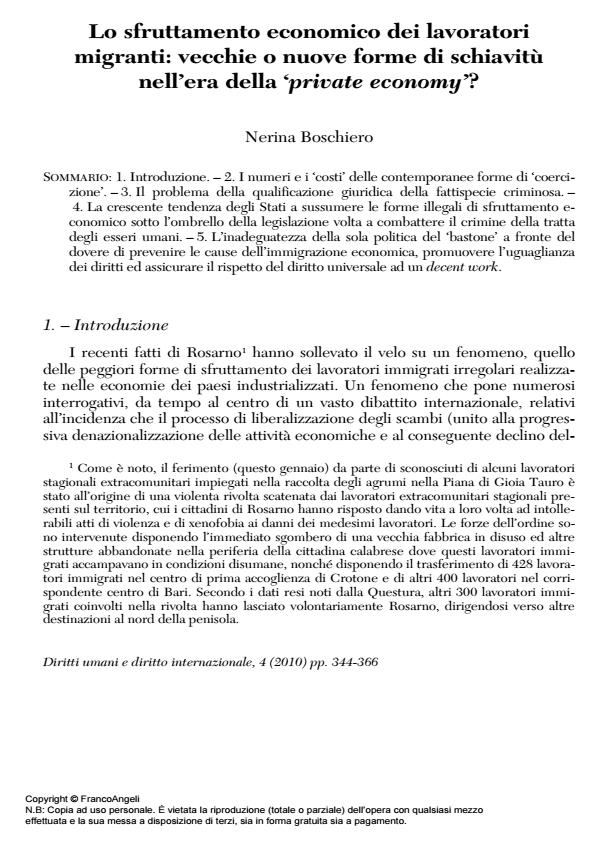Economic Exploitation of Migrant Workers: "Traditional" or "Contemporary" Forms of Slavery in the Private Economy Era?
Journal title DIRITTI UMANI E DIRITTO INTERNAZIONALE
Author/s Nerina Boschiero
Publishing Year 2010 Issue 2010/2
Language Italian Pages 23 P. 344-366 File size 511 KB
DOI 10.3280/DUDI2010-002006
DOI is like a bar code for intellectual property: to have more infomation
click here
Below, you can see the article first page
If you want to buy this article in PDF format, you can do it, following the instructions to buy download credits

FrancoAngeli is member of Publishers International Linking Association, Inc (PILA), a not-for-profit association which run the CrossRef service enabling links to and from online scholarly content.
The recent outbursts occurred in Rosarno are a dramatic example of what is generally described as the "ugly" or the"underside" of contemporary globalization, which affects virtually all continents, all countries and all economies of the world: the abusive and criminal treatment consisting in slavery and slavery like practices inflicted upon migrant workers in irregular situation, arguably the most vulnerable and least protected human beings in the world today. The present contribution outlines the impressive dimension and the salient features of "contemporary" forms of coercion and compulsion to work that occurs today mainly in the "private economy" and which represent a high legal, as well as moral and economic, priority concern for all governments. Despite the fact that the above mentioned human rights abuses mostly involve private agents, the international responsibility to enact legislation and policies to combat these abuses and protect the victims rests, in fact, upon States. Complex phenomena like "slavery" or "slavery-like practices", in which a component of forced labour is always present, are not easy to define. This is why this article starts by drawing a clear distinction between severe violations of human rights and restrictions on human freedom that amount to "crimes" under international law and other "practices" constituting a breach to labour rights which do not necessarily amount to forced labour "exploitation". Due to the fact that a very thin line divides coerced and non-coerced work, with a wide range of possible situations in-between the two extremes of the spectrum (with, at one end, slavery and slavery-like practices and, at the other end, situations of freely chosen employment), only national Courts can ultimately determine the gravity of the offences and state when specific actions should be punished as "forced labour", "trafficking" or other forms of labour exploitation and abuse. In this context, the Italian judges and prosecutors have accomplished their task by classifying the offences occurred in Rosarno against a number of irregular migrant workers, employed "informally" in the agricultural sector, as contemporary forms of "slavery-like practices" imposed by a range of private actors involved in organized crime. for forced labour purposes and trafficking in human beings. The judges went so far as to speak of trafficking in human beings. Human trafficking for labour exploitation is definitely one of the "newer" pattern of forced labour related to globalization and recent migratory trends, as well as one the most blatant failure of labour markets and global governance. Increased demand in Western industrialized countries and emerging economies (countries of destination) for cheap, low-skilled labour in various sectors, often involving "3-D" jobs (dirty, degrading and dangerous), generally unmet by available or unemployed national workers, combined with increased migration control and restrictive immigration law and policies, have provided over the last decades for a significant impetus to labour flows, fuelling the market for smuggling and trafficking of vulnerable migrants. Following the adoption of the Protocol to Prevent, Suppress and Punish Trafficking in Persons, Especially Women and Children, (the "Palermo Protocol"), which supplemented the United Nations Convention against Transnational Organized Crime, considerable attention has been devoted to the criminal aspects of labour "exploitation". States parties were required to adopt legislative and other measures necessary to classify as criminal offences the conducts set forth in Article 3. This article introduces (for the very first time) the legal concept of "exploitation" in international law, specifically defined to include forced labour or services, slavery or similar practices, servitude and various forms of sexual exploitation. This operation could reveal itself extremely useful as it allows a fundamental link between the Protocol and the ILO Conventions on forced labour, thus facilitating the task of implementing both instruments at the national level. The Italian’s implementation of this new international instrument has proven to be particularly effective in combating organized crime by securing cooperation by victims, through compensation schemes and reintegration programmes.
- Transnational, European, and National Labour Relations Laura Calafà, pp.39 (ISBN:978-3-319-02218-5)
- Allarme sociale e migranti: l'esperienza di un quartiere CEP a Napoli tra inclusione e segregazione Antonio Acierno, Gabriella Esposito De Vita, in ARCHIVIO DI STUDI URBANI E REGIONALI 114/2015 pp.73
DOI: 10.3280/ASUR2015-114004
Nerina Boschiero, Lo sfruttamento economico dei lavoratori migranti: vecchie o nuove forme di schiavitù nell’era della ‘private economy’? in "DIRITTI UMANI E DIRITTO INTERNAZIONALE" 2/2010, pp 344-366, DOI: 10.3280/DUDI2010-002006